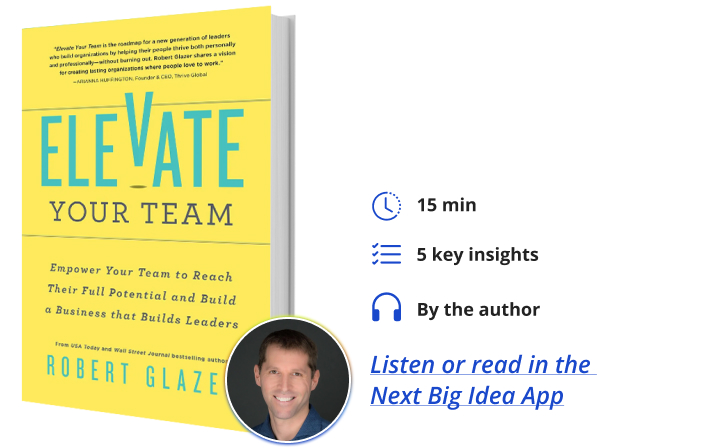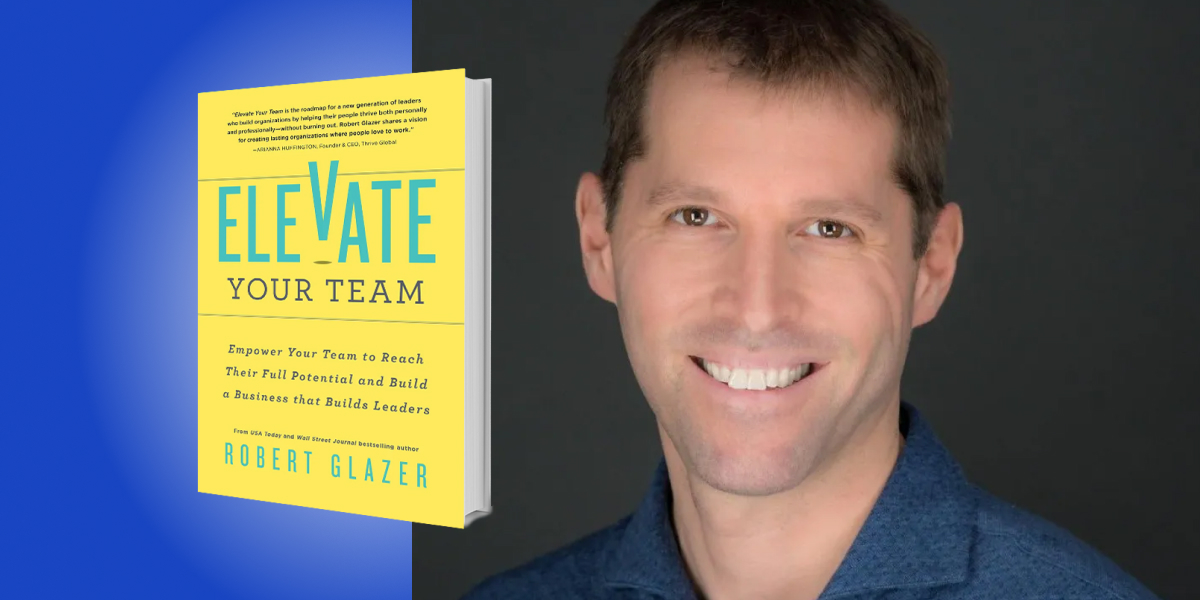Robert Glazer is a best-selling author, founder and board chairman of Acceleration Partners and host of the Elevate podcast. Glazer was also named to Glassdoor’s list of Top CEO of Small and Medium Companies in the US, ranking number two.
Below, Robert shares five key insights from his new book, Elevate Your Team: Empower Your Team to Reach Their Full Potential and Build a Business That Builds Leaders. Listen to the audio version—read by Robert himself—in the Next Big Idea App.

1. Capacity building is the key to improvement, for individuals and organizations.
Capacity building is how you develop the skills to reach your full potential, or, to put it another way, it’s how you get better. The highest performers aren’t necessarily the people with the best credentials or the most experience, they are the people who are capable of building their capacity faster than the rest of us. No matter what your starting point is, the ability to learn and grow quickly is what separates you from the pack. This is especially true in fast-growing organizations, where leaders constantly need people to step up.
There are four key areas to capacity building. The first is spiritual capacity, which is understanding who you are, what you want most, and the standards you want to live by each day—your core values. Second is intellectual capacity, which is how you improve your ability to think, learn, plan, and execute with discipline. Your physical capacity is third. That includes things like your health, well-being, and physical performance. The final key area is emotional capacity, which is how you react to challenging situations, your emotional mindset, and the quality of your relationships. You’ll notice that these four core competencies affect our behavior at work and outside of it. This is not a coincidence; we are not different people in our personal and professional lives.
What we do outside work affects our professional performance and vice versa; building capacity in one sphere inevitably affects the other. The key isn’t to make yourself into a better employee at the expense of your personal life, the goal is holistic growth that elevates all facets of your performance.
2. Work smarter, not longer.
In 2012, Marissa Mayer arrived with a lot of fanfare as the new CEO of Yahoo. Mayer came from Google, where she was a rising star and had developed a reputation as a workaholic. Most famously, Mayer alluded to her habit of 100+ hour work weeks as a point of pride. She was even quoted as saying she had once put in a 130-hour week. That’s 18 hours a day, seven days a week, leaving six hours for sleeping, eating, personal maintenance, and living.
“Whether intentional or not, her extreme work schedule sent the wrong messages to her team.”
What’s most remarkable is Mayer’s hard-driving approach didn’t do her any good at the helm of Yahoo. Her five-year tenure as CEO was marked by challenges on all fronts. The company spent $2 billion on 53 acquisitions, which were mostly worthless. Thirty-three percent of the employees left the company between 2015 and 2016, and of the employees left over, only 35 percent of them believed things would improve. Mayer ended up exiting the company in 2017 under significant pressure. She forfeited the last two years of her bonus and hasn’t held a major leadership role since.
What went wrong? While she clearly had a formidable task to turn around Yahoo, she clearly prioritized working hard over measurable results. Whether intentional or not, her extreme work schedule sent the wrong messages to her team. Leaders today can’t work their people to the bone anymore and brag about hero hours. Instead, they have to model and encourage good habits in order to get sustained performance and encourage people to unplug and take time off. Leaders also need to help create buffers between work and life, especially with so many people working from home and so much burnout after three years of a pandemic and the associated aftershocks.
Leaders today also need to shift from managing inputs, such as time worked and hours in the office, to clearly defined outcomes. They need to measure their employees based on achieving the desired outcomes, irrespective of how hard they work or their hours. A culture that rewards working around the clock does not guarantee better results. In fact, the only things this approach guarantees are burnout, employee turnover, and possibly even some health problems.
3. Depersonalize feedback.
Feedback is critical to growth, but feedback in an organization should never come in the form of personal or character attacks. Feedback should be focused on the behavior or actions of an employee, never on fixed character traits. For example, many managers find themselves at some point in their careers having to give feedback to a direct report about their work not being strategic enough. Instead of telling them they are not strategic, something they cannot fix, the right answer is to show examples of where the specific work delivered could have incorporated more strategic thinking or been more strategic, something fixable.
“Feedback should be focused on the behavior or actions of an employee, never on fixed character traits.”
So many employees have had their confidence badly damaged, even years later, as a result of a boss who criticized their character or personally insulted them. It doesn’t make them want to improve, instead, it makes them quit or, even worse, decide to quit mentally and stay until they find a new job. A model that works for feedback is the Situation, Behavior, Outcomes (SBO) framework: What was the specific situation? What was the problem behavior you would like to see addressed or improved going forward? Why did that behavior create a poor outcome, especially for the person involved?
4. Leadership is not for everyone.
At many organizations, there is an established norm that the only way for employees to advance is to become a manager or even to lead an entire team. However, this path is not right for everyone. Many strong individual contributors, who are excellent at what they do, don’t have the skill set or desire to be a leader. Asking even the best individual contributor to be a manager is really asking them to do a completely different type of job. Putting strong individual contributors who don’t want to manage into manager roles is a no-win scenario. In this case, the individual contributor gets stuck with a manager role they don’t enjoy, and their direct reports are stuck with an ineffective leader. Many people take on management roles they don’t want because they don’t think they have any other options to grow.
Leaders shouldn’t force people to become a manager to advance or get higher levels of compensation. Instead, organizations need to create a path for individual contributors and tie compensation to the output they deliver for the organization. As an additional step, it’s also a good idea to give new managers a rip cord they can pull, if and when they realize that management isn’t the right choice for them. This happens more often than you’d think, and it’s always helpful to have a graceful off-ramp when you know you’ve made the wrong choice.
5. In hiring, prioritize aptitude over experience.
In fast-growing organizations, it can be hard to hire someone for your team today when you may need an entirely different level of work from that person within a couple of years, or even a few months. If your ideal employee is someone who can elevate their performance as the organization grows, the key is to identify people who demonstrate a high level of aptitude, and either hire or promote them. Even if these high-aptitude candidates or employees don’t have as much experience when they join or are promoted, their growth trajectory will get them up to speed faster than you’d think. While experience is valuable, it’s not a guarantee of fast growth.
To find the person who can do the job today and tomorrow, you have to look deeper than the resume. Here are some traits to look for in the hiring and promotion process for people who have high aptitude:
- Promotion in place: people who have been promoted quickly and multiple times within a single organization, where they’ve stayed for a few years rather than always finding a new job to move up.
- Renaissance people: people who have proven themselves in a wide range of roles, projects, or skill sets tend to be fast learners who adapt to change and will step up to do whatever the organization needs at a given time.
- Drive to learn: you can almost always tell if someone is obsessed with learning when you talk to them. See how they respond when you ask them what books they’ve read, what they’ve done to learn and grow within their role, and what they’ve done to take ownership of their own team’s growth.
- Pull, not push: if a candidate has changed jobs often, it’s actually a good sign if that is a result of former managers or colleagues recruiting them to join a new organization. High-capacity people are recruited by people they know, rather than constantly finding new jobs through people who have never worked with them before. That’s a red flag!
To listen to the audio version read by author Robert Glazer, download the Next Big Idea App today:































